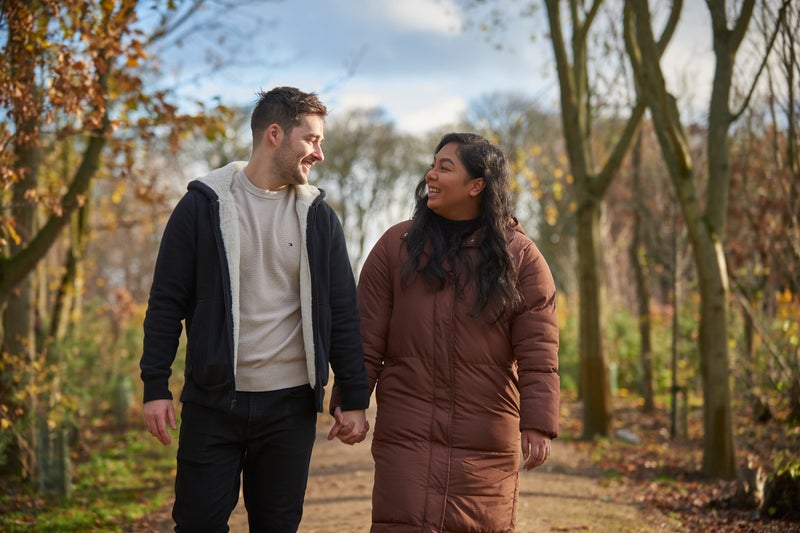The January blazes wiped out a thriving communal food pathway unique to the Altadena neighborhood, but farmers are starting to plan for its renewal. In Choi Chatterjee and Omer Sayeed’s Altadena backyard, beehives produced pounds of honey, copious amounts of fruit and vegetables were harvested, and hens laid plenty of fresh eggs. A couple of pygmy goats and a pair of 100-pound tortoises, Layla and Manju, roamed the urban farm, keeping the weeds trimmed, the compost turned and the soil alive with microbes, much to the delight of the hundreds of visitors who have enjoyed free tours and home-cooked meals since the couple began offering them in 2020.
![[A fire-scarred landscape.]](https://i.guim.co.uk/img/media/7ca15bba1e23480223c098db6eec70661133681c/0_0_3300_2475/master/3300.jpg?width=465&dpr=1&s=none&crop=none)
Passersby were often drawn to the Chatterjee-Sayeed residence since the lush butterfly-filled parkway next to their home has served as a free communal garden for more than a decade. Neighbors were welcome to stop by for persimmons, guavas, nopal pads, herbs and varieties of citrus. “We’d get 100 to 200 pomegranates and just hand them out to whoever was walking by,” said Chatterjee, who is co-director of the Urban Ecology Center at Cal State LA. “It was just bustling with life.”.
![[Fruit and vegetables on a table.]](https://i.guim.co.uk/img/media/ebb9a80d0540129002f3b3363a9ae3bea8d07bfa/0_0_3300_2475/master/3300.jpg?width=445&dpr=1&s=none&crop=none)
That all changed when the Los Angeles wildfires, supercharged by high winds and the effects of climate change, broke out on 7 January and the couple lost their 102-year-old home and beloved backyard farm. Although their goats, tortoises and some fish from their pond were saved from the blaze, it wasn’t possible to evacuate their chickens, rare pigeons or the chatty Amazon parrot they rescued nine years ago.
![[Two people hug at a community meeting.]](https://i.guim.co.uk/img/media/d2a905f65894f946d11c5c1d1212427f35d90758/0_0_3300_2475/master/3300.jpg?width=445&dpr=1&s=none&crop=none)
Countless urban farms and homesteads are gone. Hundreds of native yards burned. Cultural crops grown for generations lost. Beloved grocery stores, markets and restaurants leveled. The wind-fueled fires damaged or destroyed more than 16,000 homes and other structures, killed at least 29 people and turned parts of the nation’s most populous country to rubble. There’s also been an incalculable loss for the local food system, especially in Altadena, which has a storied history of farming, gardening, homesteading and sharing produce within the area.
![[A man stands among scorched debris.]](https://i.guim.co.uk/img/media/3feefe00dff40378c89fd904ad32ef58c45f9547/0_0_4000_2666/master/4000.jpg?width=445&dpr=1&s=none&crop=none)
“When you’re talking about local food security, Altadena was a total outlier in LA county for what it was able to do for its community,” said Anna Rose Hopkins, co-founder and executive director of Farm2People, a food justice-centered non-profit organization based in Los Angeles. “There were many official and unofficial pathways to exchanging food.” Now that those pathways have been ravaged by fires and thousands of residents have had to vacate their neighborhoods, experts worry about the impact on people’s access to food, hunger and the future of growing in a region that was blanketed in toxic ash and chemicals.
![[People in front of a table stocked with food.]](https://i.guim.co.uk/img/media/374716879e6ac429525beb9344a1075ee313cdf5/0_0_3300_2475/master/3300.jpg?width=465&dpr=1&s=none&crop=none)
If you strike up a conversation with an Altadena local, you’re likely to hear about someone’s massive plum harvest or another’s compost pile, or why a neighbor’s avocados didn’t do well last year. Because Altadena is unincorporated and has different zoning laws than other parts of Los Angeles, it’s common for people to keep poultry, have backyard vegetable gardens, take part in produce swaps and offer free boxes of hyperlocal harvests for anyone to take and enjoy.
In the 1960s, Altadena underwent rapid demographic changes thanks to a combination of white flight, political movements and urban renewal. The ending of discriminatory redlining helped make Altadena a multiracial paradise of sorts where Blacks, Asians, Latinos and Indigenous people could find affordable housing in a bucolic setting. The area has a strong rural past and soil that was known for being able to grow almost anything.
The verdant 2.5-acre Altadena community garden epitomizes the back-to-the-land spirit the neighborhood is known for. Founded in 1970, it acted as a living classroom for school groups and other community visitors who took home free plantings and seeds. When the garden burned down last month, it was a devastating loss for the 120 members who grew all types of greens, sugarcane, corn, tomatoes, colorful flowers and a variety of herbs on 84 plots.
“I would say a majority of the people depended on what they grew to eat and a source of their consumption,” said Mary McGilvray, vice-president of Altadena community garden, who noted that 44 of its members’ homes were also lost. “We have people from all walks of life, representing 12 different countries – you can throw a stone and hit an artist or scientist.” That diversity of growers meant you’d see things like jamaica, the dried flower of the hibiscus plant used in Mexican cuisine, and tamarind, widely used in curries and chutneys.
The garden’s annual picnic, featuring garden-grown food, was one of the area’s biggest events, drawing up to 1,000 people at times. Although everything except for a wooden deck and some metal fencing burned down inside the garden gates, a huge variety of free-to-the-public citrus and guava trees located outside the perimeter survived, offering a bit of hope. The garden is currently fundraising to help remediate the soil and rebuild the garden and structures.































